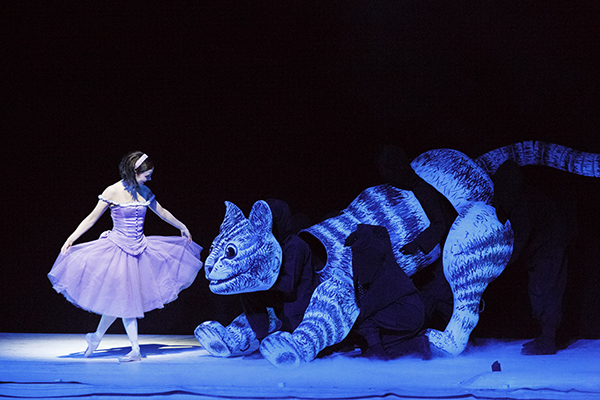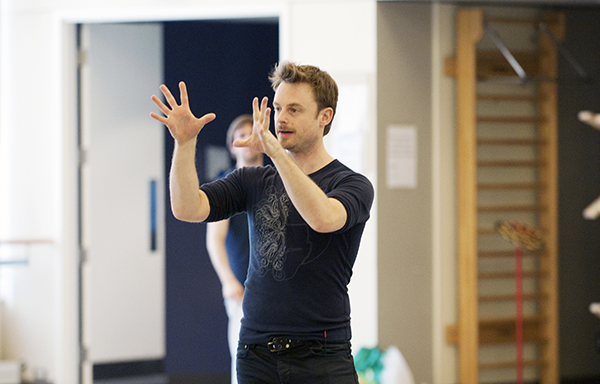Ballet
News+
Wheeldon in Wonderland
by Mark Monahan
February 1, 2019

Mark Monahan: So, what first drew you to the story of Alice's Adventures in Wonderland?
Christopher Wheeldon: I grew up listening to a tape of Alice in Wonderland that I was given one Christmas, a childhood thing to get me to sleep. Of all people, it was Kenneth Williams reading it – not exactly the dulcet tones to send your child off! I loved the characters, and came to love the mysteries and mathematical problems and wordplay that are locked in to the literature. It was the vividness of the book’s characters, and the way they all lend themselves to being communicated through movement – it’s a very physical story.
MM: What aspect of the production did you tackle first?
CW: Many of the problems with Alice's Adventure's in Wonderland stem from its episodic nature. The challenges we faced were: what is Alice’s journey? Does she just fall down the hole, have all those crazy episodes and then wake up? Or is there more of a journey? I’ve developed synopses before by myself, but never brilliantly. And so, I thought: get some help here, because this is too important. I wanted someone with a real sense of how to put together a dramatic arc over the course of an evening, and that’s why I got Nicholas [Wright, the playwright] involved. I spent three fantastic days in my apartment in New York with him and Joby [Talbot, the composer], just reading the books, and I hired in a little keyboard so Joby had something to tinkle around on. We went through it, scene by scene, first deciding which ones would work best in this production, then settling on a structure. After that, Joby and I went at it the old-fashioned way, as choreographer and composer.
MM: How did that process work?
CW: I had never worked on a new, full-length narrative score. Joby had written a lot for film, and had orchestrated fantastic dance pieces too: Chroma [for Royal Ballet Resident Choreographer Wayne McGregor], and my Fool’s Paradise. In both, he created these unusual, shimmering orchestral colours that to me felt absolutely like the right direction with Alice's Adventures in Wonderland – it’s a fairytale, but it’s absurd and a little strange, and I needed a composer who could take those elements and create a big symphonic score. His work in film has really helped us, because he knows how to write for character – but then, film is very different from dance, and so for Joby it was about learning how to structure a variation for a dancer, and so on. After those days in New York, it was a case of: OK Joby, off you go! Every step of the way, we were talking, and he would send me pieces he’d written. Even going only by the computerized simulations of the orchestra, you can tell his score is very vividly drawn, just like the characters in the Carroll. I love it, and it’s accessible too – and that’s important. Alice's Adventures in Wonderland is a ballet we hope all sorts of people will come to over a long period.
MM: And how did you approach the choreography?
CW: Most of my work so far has been kind of exploring the abstract. What I’ve learnt from Alice's Adventures in Wonderland is that if you’re telling a story, the story comes first: your job as a choreographer is of course always to communicate through movement. But here, above all, it is to convey the building-blocks of the story, and then, within that, to explore vocabulary to define individual characters.
MM: The Carroll story is not without its dark side, and nor – it has often been suggested – was Carroll himself. How did you decide on an emotional ‘register’ for your Alice's Adventures in Wonderland?
CW: Well, I did a lot of research on Lewis Carroll, and I do think there was some kind of strange, complicated, repressed part of his character. But there’s certainly no proof that he ever acted upon it – these creative people do exist who have a connection with children. I prefer to believe that Carroll was in fact the brilliant storyteller, mathematical scholar and devout churchman that a lot of people believed he was. So no, I haven’t gone Freudian with Alice's Adventures in Wonderland – there’s no MacMillanesque suicide pact at the end, and nor is there any suggestion of authorial impropriety. But on the other hand, there is an underlying, scary darkness to the story. I think that’s what makes it appealing for kids, and we’ve kept that.
MM: So, when did you actually start working on the steps?
CW: In February of 2010 – The Royal Ballet were keen on it being a year-long process. I work very quickly, always have, and that stems from being in New York and working at New York City Ballet. Everything’s done quickly there, and that goes back to Balanchine and Robbins: you make a lot of work, keep some, scrap some. So, the idea of taking a year to make a ballet was odd to me. I thought, “Come on guys – I could make three full-length ballets in a year!” As it turned out, The Royal Ballet just don’t work that way. It was a case of, “You can have one rabbit, in a small studio, for an hour and a half”, and then for three days there’d be nothing, because they’d be getting on with Mayerling or whatever.
MM: Why such a difference?
CW: In New York, it was bang, bang, bang – you learn a ballet in a day, you’re on in the evening. But in London, the ballets are big and involved – you can’t just throw, say, Mayerling at the stage. Whereas the Balanchine ballets are about understanding musicality and choreography, they’re not really about developing character.
MM: Dance is necessarily a collaborative discipline between choreographer and dancer, but to what extent is this true for you?
CW: I never “prep”, never go into a room on my own and create vocabulary – I love exploring things with dancers. But at the same time, Alice's Adventures in Wonderland is actually the clearest I’ve ever been. I really knew what I wanted out of this ballet.

MM: Were you tempted to dance in it yourself?
CW: Oh no, no… The Duchess is probably the only role I could just about carry off!
This interview is excerpted from The Royal Ballet house programme, courtesy The Royal Opera House.
Mark Monahan is Dance Critic of The Daily Telegraph, London.
Alice's Adventures in Wonderland is onstage March 7 – 17, 2019.